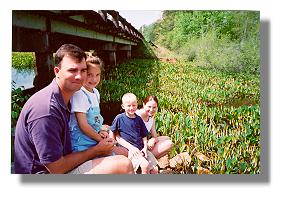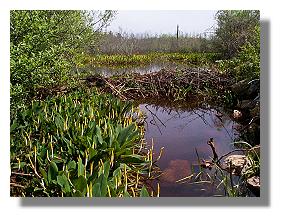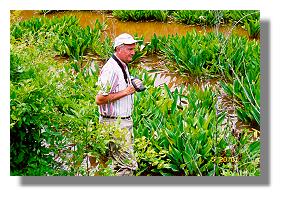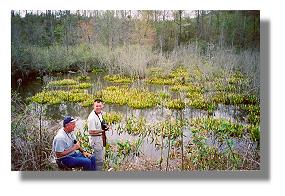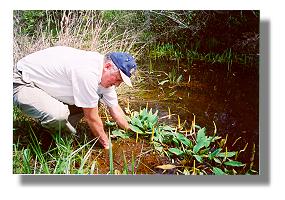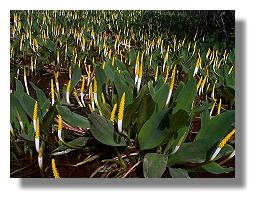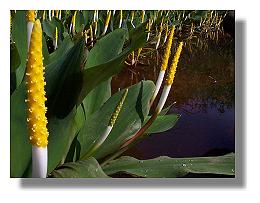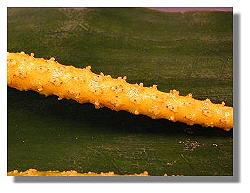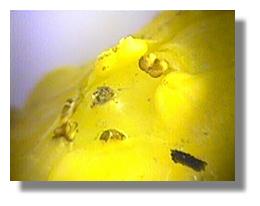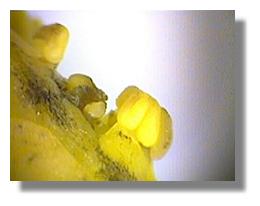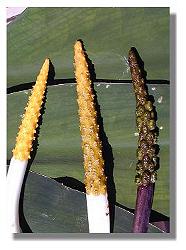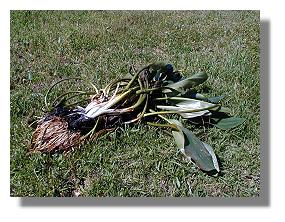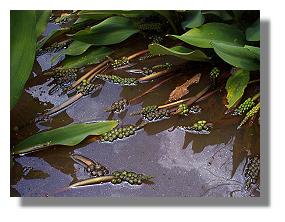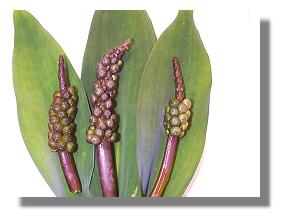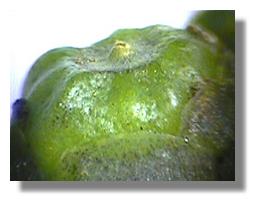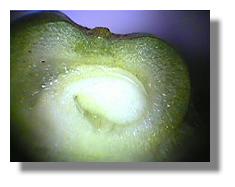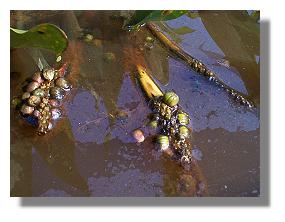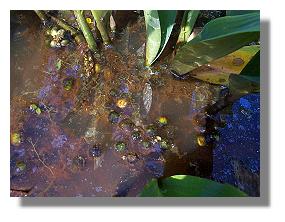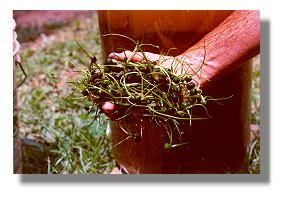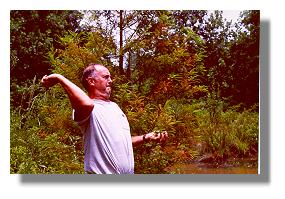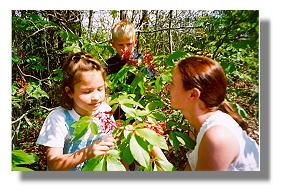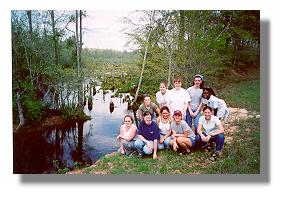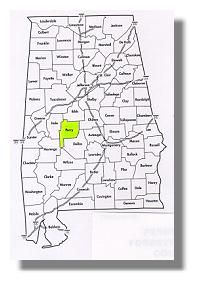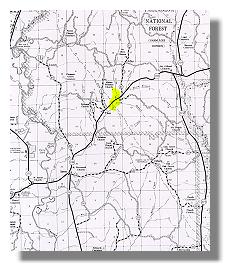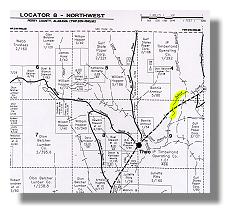|
An Unusual Occurrence of
Golden Club, Orontium aquaticum L.,
in Perry County, Alabama
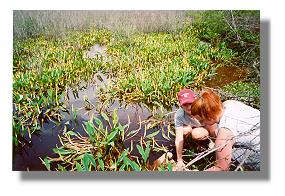 |
By Thomas H. Wilson, Ph.D.
Judson College,
Marion, Alabama
Spring-Fall of 2001
[images and html coding done by the
author]
|
Golden club is an unusual and attractive member of the Araceae family of
plants. This marsh/swamp and acid stream arum is related to Jack-in-the-pulpit,
skunk cabbage, and garden calla lily. The golden club population of this study
is located in a 65 acre Mill Creek marsh east of Marion, Alabama, in Perry
County. In early spring this marsh is covered with this beautiful lily with its
brilliant golden yellow spikes and its dark bluish-green leaves.
This unusual ecosystem is being studied by Thomas Wilson and the biology
students at Judson College in Marion. Efforts are being made to protect the
marsh which will add another significant natural area to the outdoor wonders of
Perry County.
Golden Club lilies bloom in Perry Count, Alabama, from late winter through
mid-May. Golden Club is endemic to the Coastal Plains of North America. This
arum normally occurs in acidic water of swamps, bogs, marshes, and other
tanniniferous waters. The water in this particular habitat had a pH of 5.4 on
Thursday, 21 June, 2001, @ 8:30 am (bright sun on this soltice day).
This Perry County population is thought to be the thickest colony of golden
clubs in the World. The author also observed Golden Club plants in a marsh of
the Oakmulgee Wildlife Management Area in Bibb County, Alabama.
The leaves of golden club are dark, velvety bluish green. The leaves have a
waxy epidermal layer which strongly repels water and the plant is often called
"never-wet."
Golden club is the only arum species which does not have a spathe (hood formed
from a leaf). The spadix is borne on an elongated scape, which is white
distally and erect or ascending during flowering. The perianth (floral parts)
is green when the flowers are young but turn yellow before and during
pollination. The flowers are mostly bisexual, becoming staminate (male)
apically.
The tepals (combined sepals and petals) are yellow and are arched over the
ovary. The staminate flowers (anther and filament) surround the single ovary.
Changes in color of perianth segments during the reproductive cycle is from
green when immature, golden yellow at anthesis (pollination) and again green
during fruit formation. Golden club grows from a large rhizome that is often
deeply sunken because it produces contractile roots that pull the plant into
the mud.
As the fruit matures, the peduncle bends into the water and the spadix decays.
Fruit maturation occurs in the water.
The single ovary contains one basal ovule. The ripe pericarp is thin, fleshy,
and contains air spaces.
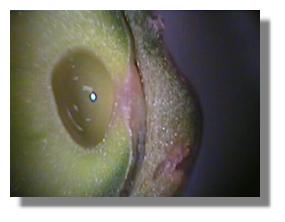 |
A section of the golden club ovary reveals the developing monocot embryo
that possesses a central cavity. The locule (space between seed and pericarp)
is mostly filled with a slimy, jellylike mucilage. |
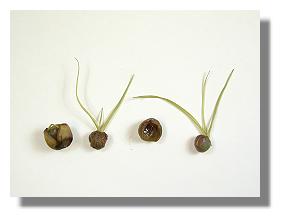 |
Seed germination in golden club begins with splitting of the pericarp and
the emergence of the first three plumular leaves. These leaves continue to grow
and the seed is freed from the pericarp. |
The spongy pericarp makes the abscised fruit float which is the major means of
seed dispersal. The pericarp eventually splits at the apex and the seed is
released and immediately sinks. As the seed develops it sprouts a radicle with
is the embryonic root of the plant.
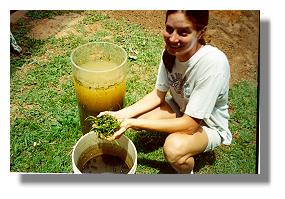 |
Floating seeds were collected from the area and placed in containers filled
with swamp water. As the seeds shed their pericarp coverings and sank to the
bottom, they were gathered and planted in the author's backyard wetland. |
The life history of the golden club plant in this Perry County marsh is an
ongoing project for Dr. Wilson and his biology students at Judson College.
Wilson also is compiling a list of golden club pollinators and is conducting a
study of the entire ecosystem. Greg Harber of the Birmingham Audubon Society is
assisting in the bird count for the area.
The Perry County Plat Directory distributed by the Perry County Forestry
Planning Committee (copyright 2000) page 38 uses the name Dobyne Creek for the
section of Mill Creek containing this golden club colony. The U.S Geological
Survey Quadrangle map of Perry County does not use the name Dobyne Creek for
any portion of Mill Creek. Dobyne Creek is an improper designation of a section
of Mill Creek.
II am very grateful for the interest, encouragement, and professional support
that I received from the following scientists during the course of this study:
Dr. Larry H. Klotz, Department of Biology, Shippensburg University,
Shippensburg, Pa; Dr. Sue Thompson, Interim Executive Director, Pennsylvania
Biodiversity Partnership, Pittsburgh, Pa and Dr. Thomas B. Croat, Missouri
Botanical Garden, St. Louis, Mo, president of the International Aroid Society,
Inc. Bob Reid, lawyer, environmentalist, birder and good friend introduced me
to the golden club environ. Bob is leading the effort to protect and preserve
this wonderful part of wild Alabama.
|

